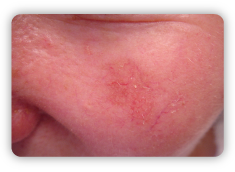MOLECARE ORMUZ AVENUE
Sun Spots and what they indicate
Sun spots (damage to squamous cells): Solar keratosis (also known as actinic keratosis, and commonly known as sun spots) occur as a result of damage to the DNA of the squamous cells in areas of skin that have been regularly exposed to the sun over time (nose, cheeks, lips, ears, temples, forehead, neck and hands) especially on fair-skinned people.
Sun spots can initially only be felt to the touch as a single rough spicules or sand paper-like patches. As they mature, sun spots become visible as dry scaly patches from 2mm to 20mm diameter, which may be white, skin-coloured, pink, red or light brown in colour. Sunspots may be itchy or sting when scratched or exposed to sunlight.
Sun Spots as a marker of DNA damage to the skin: Sun spots are generally harmless however their presence is evidence that the skin’s DNA has been damaged and that person is at an increased risk of developing skin cancers. People with more than 10 sun spots have a 10-15% chance of a sun spot developing into a skin cancer called squamous cell carcinoma. As a result, sun spots are usually treated with cryotherapy, electro cautery or prescription skin creams. The development of a pink fleshy mound beneath the sun spot which becomes consistently tender to the touch, or the development of a horn-like protrusion from the centre of the sun spot can indicate that it is changing into a squamous cell carcinoma.
Previous-UV light & premature aging Next-The most common skin cancers





